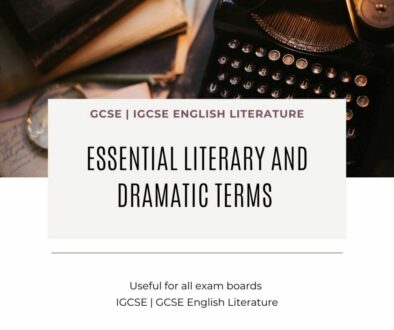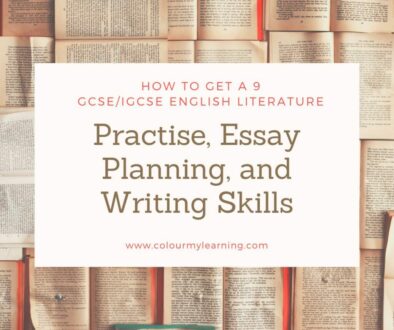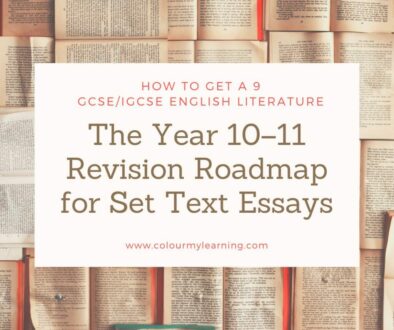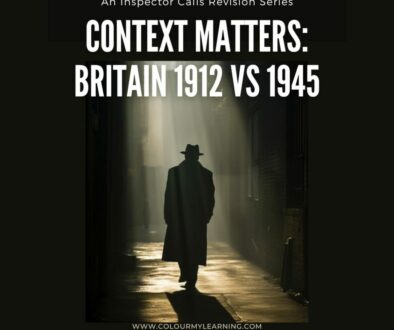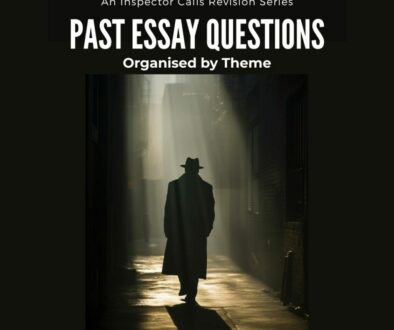How to Get a 9 in GCSE/IGCSE English Literature (Part 1): Specs, AOs, and the Three-Read Strategy
The idea of scoring the very top grade or 8 or 9 for English literature may feel like a stretch for many. And for some just passing would be sufficient, after all not everyone is a fan of analysing commentary or trying to figure out how context influences author’s choices. But if you enjoy English, and reading, and absolutely love the idea of studying literature at a higher level, then this guide is for you.
This is Part 1 of a series of 3 blog posts on How to score a 9 for your English Literature exam at GCSE/IGCSE level. Part 1 Outlines the basic preparation of getting to know the syllabus intimately, knowing what AOs you need for each question and finding out how examiners mark. In Part 2, we focus on how to allocate your time over the year or over the months leading up to your exam. Part 3 focuses on how to practise essay writing effectively and efficiently.
Who This Guide Is For
This comprehensive guide is for students who genuinely enjoy English Literature and want to achieve the highest possible grades. If you’re naturally drawn to analyzing texts, love diving deep into character motivations, and refuse to settle for anything less than your best performance, this roadmap will show you exactly how top students need to approach GCSE and IGCSE English Literature.
Parents looking for practical ways to support their child’s literature studies will find actionable strategies here. Teachers looking for a clear framework to explain what separates Grades 7, 8 and 9 responses from the rest will discover specific techniques that work consistently.
Why This Strategy Works
Unlike Science and Maths which relies to a great extent on repeated practise and memory work, English Literature rewards intelligent preparation much more than just relying on innate talent or endless hours of study. The highest achievers understand a crucial fact. Examiners have specific criteria they must follow, and top grades go to students who demonstrate those exact skills efficiently and hit the required targets effectively.
The fact is writing longer essays or memorizing entire novels or plays is not always going to help. Grade 9 students will know their texts intimately, understand how marking works, and practice strategically to build genuine confidence under exam pressure. They work smarter, more efficiently and effectively. Think of this guide as your strategic advantage. Instead of guessing what examiners want, in this article we’ll tell you exactly how to find out, what skills you need to develop and how to demonstrate them effectively during the exam.
Know the Syllabus/Specification
Every exam board, for every subject, publishes detailed syllabus information. These are often aligned with governmental guidelines (Ofqual requirements) on expectations and what should be achieved at the different standards. These documents are all easily available on the exam board websites so this should be your first stop.
Make sure you know which exam board you are studying for and whether it is a GCSE or an International GCSE (IGCSE). There is a difference. While the actual content may be similar, exam questions, timings and other details may differ. If you’re uncertain, find out from your teacher or from the Examinations Officer in your school.
The typical exam boards for GCSEs in the UK are:
AQA | OCR | Pearson Edexcel | WJEC Eduqas
Typical exam boards for IGCSEs (used worldwide):
Pearson Edexcel | CIE (Cambridge International Education)
Reading the Specification
As you read through the specifications (syllabus), keep in mind that the bulk of these publications have been produced to convince schools to opt for a specific exam board. These do not concern you as a student. You can often safely skip over the initial parts of most of the syllabus introduction. These are usually titled ‘About this specification’, and contain sections such as Using this specification, Why choose these qualifications. You can ignore these because you don’t actually have a choice in what exam board you’re sitting. This has been decided for you by the school (unless you are home-educated, but that is altogether another question).
So skip to the sections that detail the Qualifications. For example, At a Glance will give you an overall idea of what makes up the subject exam itself. This will usually be clearly labelled as Paper or Component. It will contain the break down of what will be examined in each paper, percentage marks it carries, how much time is allocated for each paper and what is expected of you as teh student. For eg, it might say Students will answer one essay question from a choice of two.
The following sections will then list all of the texts that are available for study. Our recommendation is to just go along with what your school has chosen for you. If you have the option to choose, as smart thing to do might be to look at past year questions and compare them to the text that you’re interested in.
Assessment Information & Requirements
The most important and pertinent part of reading the specification is entirely in the Assessment information and requirements. The whole purpose of getting to know the details of the specifications is really in knowing how you will be assessed. Look at the weightings across the papers. Longer papers usually have heavier weightings.
There will also often be recommended timings, ie how long to spend on each question. While a very crude rule of thumb is generally 1 – 1.5 minutes per mark, you will be able to find your own system with time and with practise.
Look closely at the Assessment Objective (AO) distributions and be clear what the examiners are looking for in each paper and each question. You will often find that not all AOs are assessed in every question. Being strategic about this means that you can be very ‘on point’ with your essay answer. If no marks will be awarded for context, then you will not need to include context for every point. Having said that, understanding the motivations and intentions of the author and managing to convey that to support your answer will always make it stronger.
Note how each of the AOs are marked. Some will be weighted more heavily that others. Make sure you know which ones to ensure that you pick up the maximum marks.
Another point to remember is that marks are to some extent subjective within English Literature marking. Unlike Maths and Science subjects where it is possible to achieve full marks, in English Literature it is more challenging to accomplish. That said, strive to pick up all the marks that you can.
So, now that you know how and where you’ll gain marks and where you can optimise for this marks.
Understanding Assessment Objectives: Your Route to Grade 9
Now that you’ve identified what’s important in your exam, look at each AO in detail and make sure that you understand what is required for each. Hitting each of these is where you will earn every mark. If you can show clearly that your points/topic sentences, supporting evidence and examples align with the AOs, then you’ll be awarded the mark. These are where the marks that will determine your final grade come from, so understanding them thoroughly will give you enormous strategic advantage.
Pearson Edexcel English Literature IGCSE Assessment Objectives

AQA English Literature GCSE Assessment Objectives

The two screenshots above show the AOs from two different exam boards and two different exam types (GCSE and IGCSE). On the whole their intentions are broadly similar, but in detail they differ slightly. The Pearson Edexcel, places a bit more emphasis on context and relationships between texts (you are asked to compare different texts), while context is embedded within AO3 for the AQA GCSE version.
AO Weightings and Distributions
When you look in further detail in to the weighting distribution of the AOs, you will also find that AQA has quite a different level of expectations for each of its AOs compared to Pearson Edexcel.
These are here only for you to understand that it is important to know what is required and expected of you, within your own exam board.
It is difficult to generalise then what is required for each AO, and how to achieve it without knowing the exam boards that have written them. So our advice to you is to know the AOs intimately. Know what is required for each question and each section of every paper. Not all questions will have all four AO requirements. Most will need at least AO1 and AO2, but AO3 and AO4, will be different depending on which question and the purpose of the question.
These will be broken down further in the explanation of the exam paper under the Specifications.
The (At least) Three-Read Strategy
Now that you have become familiar with what is required of you in the exam and for each exam question, the most important thing is to really become familiar with the texts that you have to study. Here’s where we recommend an (at least) three read strategy. If you manage to go over the entire text more than that, that’s brilliant, but any less, is usually insufficient to really get to know the text well.
Your First Read: What’s the Story and Your Emotional Response
Your very first read should be purely for engagement and understanding. Read the book as if it were just a story you’re curious about.
- Follow the plot naturally. (Pride and Prejudice: What happens when Jane catches a cold? In fact, why does she catch a cold?)
- Notice which characters you like or dislike. (Which character are you most alike? or who would be your best friend or even your sworn enemy?) Thinking about your text in these terms helps your personify the characters and understand theirs and hopefully their author’s motivations and directions.
- Identify themes that resonate with you personally.
You do not really need to take notes in your first reading. In fact we would advise you to just ‘enjoy the story’ deeply and thoroughly. Simply enjoy the experience of discovering the story. Mark confusing sections (if there are any) or particularly striking moments, but avoid making any detailed analysis.This first read is meant to build your foundational understanding, which will support all later analytical work.
Your Second Read: Observe Character Development and Build Your Quote Collection
In your second read, start to read analytically. Track how characters change throughout the text, note the specific moments that reveal their psychology, motivations, and flaws.
Begin building your quotation bank systematically. Look for lines that:
- Reveal character psychology at crucial moments
- Demonstrate important themes through concrete imagery
- Show the author’s distinctive writing style
- Work across multiple potential essay questions
Aim for 25-30 quotations per text during this read, which you’ll later refine down to your golden collection.
Third Read: Analytical Detail and Technique
Your final read focuses on the author’s craft. Notice patterns in imagery, structure, and language use. How does the author create atmosphere? What techniques build tension or convey themes?
This read should feel like detective work. You’re looking for the deliberate choices that create the text’s overall effect. Pay attention to:
- Repeated words or phrases that gain meaning through repetition
- Structural decisions like chapter divisions or scene breaks
- Contrasts and parallels between characters or situations
- Moments where form and content work together powerfully
By your third read, you should feel like an expert who could discuss any aspect of the text with confidence.
Next, learn when to start revising and what to do throughout Year 10 and 11 leading up to your exam.


